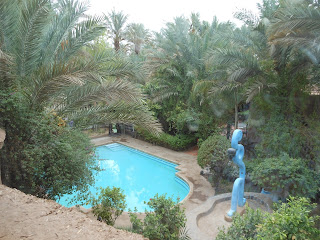4 September 2014
 |
| Part of the square in the centre of Ouarzazate |
Leaving Ouarzazate, we
travelled through seasonally barren countryside directly to our
overnight stop at another gorgeous riad, this time in Zagora, before
doing the real exploring of the day. In September it was almost
impossible to imagine either crops or snow along this route, but that
is what happens. Apparently 🙂
 |
| On the road ... |
Everywhere I stayed was
different and wonderful. I was very conscious of the difference
between where I stayed and where the locals lived. Tourist
accommodation is much more akin to dwellings of Very Rich Moroccans.
 |
| My quarters and stairs leading up to my rooftop terrace. |
 |
| The library at my riad in Zagora .... looking rather under-used. |
There were only a couple of
small towns along the way, but hives of activity. The mud-brick
buildings always amazed.
 |
| Near Tinzouline |
After getting settled and
having lunch, we were off, through the D’raa Valley and its
ever-present palm groves. I was just a bit early for date season, the
trees bearing so many still-ripening fruit. Our goal was Tamgroute ,
in particular a pottery collective and a very special library.
If you google ‘Tamgroute’,
you will come up with similar looking names such as Tamgrout and
Tamegroute. These variants are an example of what frequently happens
when a Berber or Arabic name is transliterated into English script.
 |
| Palms in the D'raa valley |
The haziness in the D’raa valley is typical of what it was like for pretty much the whole
trip - muted shades rather than sharp colours.
First stop at Tamgroute was
the pottery, venturing into the mysterious buildings that you saw
along main roads. It was a real rabbit warren, very easy to get lost
in … pretty much like any medina! The smell in some parts more than
hinted at the lack of western plumbing.
 |
| Behind the walls of Tamgroute ... |
 |
| .... into the alleyways, some of which were pretty dark. |
Finally we reached the
pottery. Collectives (pottery, weaving, whatever) typically seemed to
be incorporate a small number of families (5-10), enough to be able
to provide the infrastructure and manpower to make it viable. The
potting wheel was a set-up I’d never seen before. I got a bit of a
shock when the potter jumped into a hole in the floor! You couldn’t
see his feet in action, spinning the wheel.
 |
| Potting |
 |
| Then into the oven |
The finished products come
in all shapes, colours and designs but the colour for which Tamgroute
is famous is a particular green, a “secret recipe” mix of
manganese and copper.
 |
| Unfortunately 'not' showing the famous Tamgroute green |
Bearing in mind size, weight
and breakability, I bought a mini, mini famously green tagine which
friends now have sitting on their dining table, used as a mini salt
pig. For myself I bought a bowl vaguely reminiscent of Cornish Blue
kitchenware.
 |
| My little blue and white striped bowl - 9 cm diameter at the rim |
Then it was on to that
special library. It is called the Koranic Library but it is much more
than a place of theological study. Tamgroute is a centre renowned for
the broad education it has offered over the centuries. Most of the
current buildings look pretty new although the library was
established in the 17th century.
 |
| Forecourt and mosque at the educational precinct. |
 |
| Approaching the library, which is to the right of this photo. |
The library currently houses about
4,000 texts, the oldest dating from 1032, beating by 62 years the old
Arabic text I saw back in 2011 at the National Library of Medicine in
Bethesda, Maryland. There were many illuminated texts, rivalling the
Books of Hours that you see in western libraries. A matter of great
regret that you couldn’t take photos. The library is maintained by
an older man, I wouldn’t like to guess his age. As he guided me
through the library, he was wheeled about by his grandson who is
learning the ropes and will take over from his grandfather in due
course.
 |
| Leaving the library. "Librarians" (I don't know how they describe themselves) just visible inside the doors, my wonderful driver and guide in front. |
Then it was back to Zagora.
A swim in the pool before another beautiful meal – have I mentioned
my particular love of the chicken and preserved lemon tagine? Or the
one with apricots and sultanas?
 |
| The pool at Zagora - from my rooftop terrace. |
Looking over the riad walls
from my rooftop terrace you could see dates aplenty ripening on the palm trees. Below, irrigation channels in the ground indicate plots for crops in due season.
Not a square inch of arable land is wasted.
 |
| Palms at Zagora |
Then a good night’s sleep
before the thrill of the next day – the Sahara!


